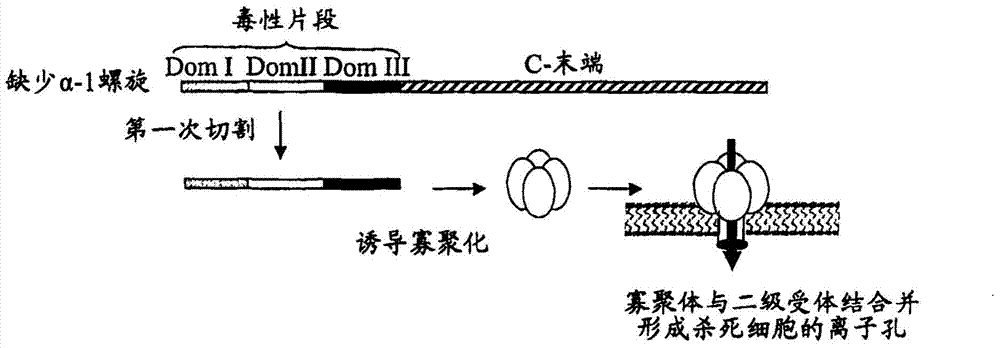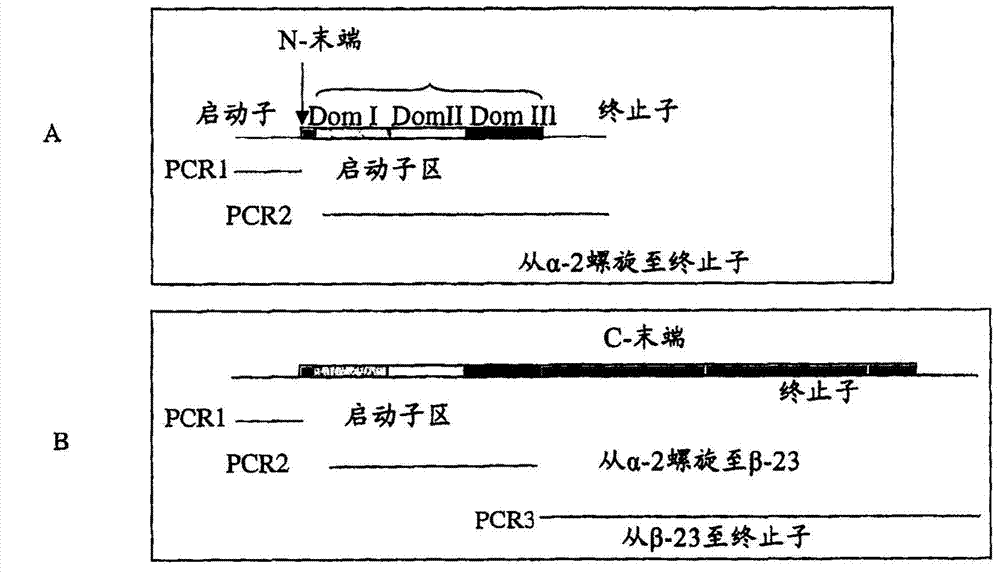Method for suppressing Bt (Bacillus thuringiensis) CRY toxin resistance of insects by using toxins needing no cadherin receptors
A toxin and resistance technology, applied in the field of using toxins that do not require cadherin receptors to curb insect resistance to Bacillus thuringiensis CRY toxin, can solve problems that have not yet been implemented in large-scale field trials
- Summary
- Abstract
- Description
- Claims
- Application Information
AI Technical Summary
Problems solved by technology
Method used
Image
Examples
Embodiment 1
[0096] Example 1. Example of a DNA construct encoding a modified 3-domain Cry toxin lacking an alpha-1 helix obtained using the method of the invention.
[0097] To illustrate the method of the invention, two 3-domain Cry toxins were chosen: Cry1Ab and Cry1Ac. In both, the promoter region, the coding region of the complete protein and the alpha-1 helix were identified as follows:
[0098]
[0099] pb, base pair
[0100] To remove the coding region of the α-1 helix, genetic constructs of modified 3-domain Crv toxins called Cry1AbMod and Cry1AcMod were amplified as follows:
[0101] In these cases, perform Figure 4 The 3 PCR steps shown in . The total DNA of the Bacillus thuringiensis strain Bt407 containing the pHT315Cry1Ab plasmid and the total DNA of the BtHD73 strain (which contain the Cry1Ab and Cry1Ac genes, respectively; according to reports in Gene Bank, accession numbers X98793 and ML 1068, respectively) were used as templates. For PCR1, the forward oligo contains...
Embodiment 2
[0105] Example 2. Obtaining vectors and host cells containing DNA constructs encoding modified 3-domain Cry toxins and their use in recombinant methods for the production of modified 3-domain Cry toxins.
[0106] A vector containing the gene constructs Cry1AbMod and Cry1AcMod cloned in the double origin of replication vector pHT-315 (Lereclus et al., 1989) was obtained. By transforming the decrystallized (acristalífera) strain Bt407Cry with the above vector - (serotype H1, Lereclus et al., 1989) to obtain genetically engineered host cells containing the construct.
[0107] To produce the modified and unmodified (wild-type (silvestre)) 3-domain Cry toxins of this example, transformed and wild-type (silvestre) strains were supplemented with 10 μg / ml of erythromycin in vegetative sporulation medium (Lereclus et al., 1995) for 3 days. Modified and unmodified 3-domain Cry toxin crystals (Thomas and Ellar, 1983) were recovered and purified by sucrose gradient and dissolved in 10 ...
Embodiment 3
[0108] Example 3. Formation of modified 3-domain Cry toxin oligomers used as examples (Crv1AbMod and Cry1AcMod).
[0109] Bt-R containing toxin-binding domain 1 Oligomer formation was promoted in vitro by protease activation of the Cry1A protoxin in the presence of protein fragments or in the presence of scFv73 antibodies mimicking these toxin binding regions of the CADR receptor (Gómez et al., 2003). When incubated with CADR fragments containing the 7-12, 11-12, or 12 repeats of CADR, the Cry1Ab protoxin produces 250 kDa oligomers ( Image 6 ).
[0110] When Cry1AbMod and Cry1AcMod protoxins were trypsinized in the absence of CADR receptors, they produced 250 kDa oligomers, but under these conditions the wild-type (silvestre) protoxins Cry1Ab and Cry1Ac did not form oligomers, but only Produces a 60kDa monomer ( Figure 7 ). These results indicate that when the modified 3-domain Cry toxins are proteolytically activated in the absence of primary receptors, they generate 25...
PUM
 Login to View More
Login to View More Abstract
Description
Claims
Application Information
 Login to View More
Login to View More - R&D
- Intellectual Property
- Life Sciences
- Materials
- Tech Scout
- Unparalleled Data Quality
- Higher Quality Content
- 60% Fewer Hallucinations
Browse by: Latest US Patents, China's latest patents, Technical Efficacy Thesaurus, Application Domain, Technology Topic, Popular Technical Reports.
© 2025 PatSnap. All rights reserved.Legal|Privacy policy|Modern Slavery Act Transparency Statement|Sitemap|About US| Contact US: help@patsnap.com



